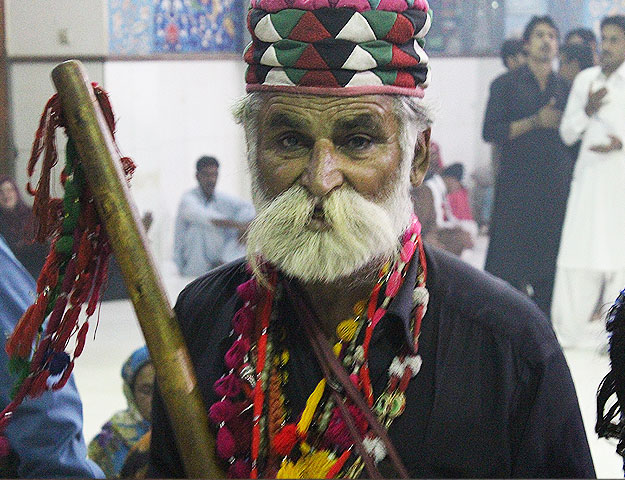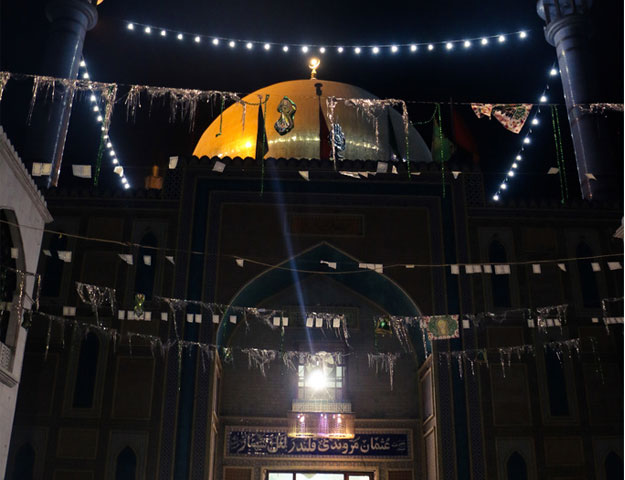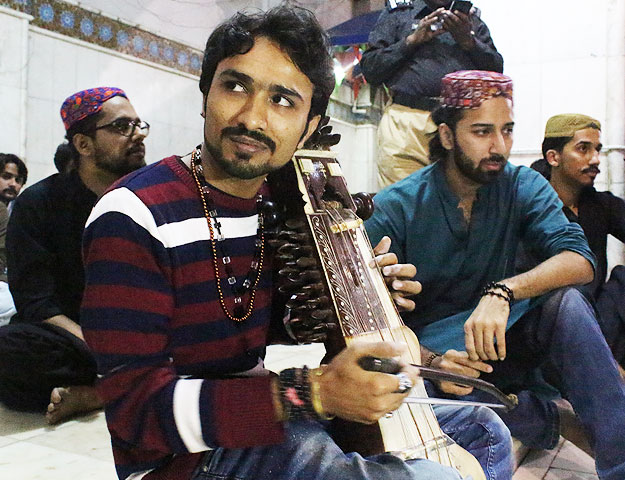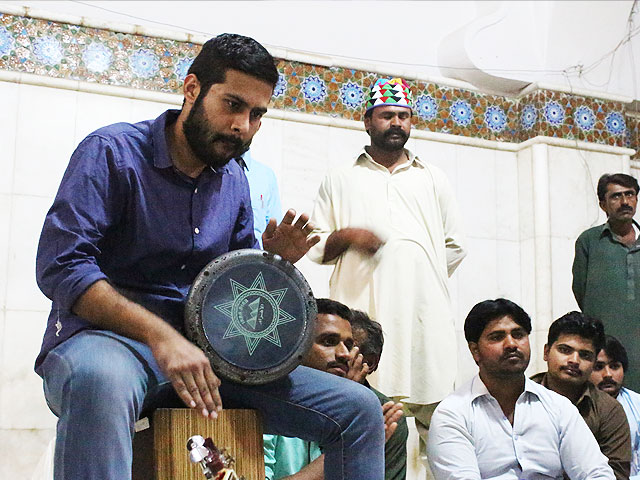
The dust has hardly settled but music is already rising from the ashes in Sehwan. City’s dwellers firmly believe that it’s Lal who is their divine guardian, bestowing them with blessings. Usman Marwandi – or Lal Shahbaz who migrated from Iran’s Marand to Sindh had to prove himself as a saint before he entered the soil which was already brimming with spirituality.
 PHOTO: RAHUL AIJAZ
PHOTO: RAHUL AIJAZOnce he was accepted, Sehwan didn’t let go of him. Many lost their self by becoming his disciple, living perennially around him when he was alive and around his grave after he died.
From the beginning in 1200’s to this date, music and losing oneself to the tune of love has kept Lal and his teachings alive. On February 16, 2017 when his followers were lost in this very tune, terrorists attacked the shrine leaving at least 90 people dead.
Little did the terrorists know that the devotees they tried to kill had already lost themselves that very day when they entered Lal’s shrine – the realm of losing one’s identity and becoming one with the beloved.
Their bodies were hit by the pellets but the explosion couldn’t affect their souls.
Nobody can stop dance and music: Sheema Kermani
The undeterred Lal’s followers vowed to hold the dhamaal following the day the blast occurred and kept their word despite the authority’s decision to seal the shrine. “No one can stop the dhamaal started by Lal. It’s not in anyone’s control, not even in ours,” said a malang, who was readying for the dhamaal inside the shrine.
 PHOTO: RAHUL AIJAZ
PHOTO: RAHUL AIJAZThe drum, called naubat, the horn which produces the sound of ‘Haq Haider’, the dhol, and ghungroos worn by faqeers at the shrine collectively make a transcendental environment – without which Lal’s abode seems incomplete. “Such is the magic of Lal’s teachings that every singer in the country has to sing Dama Dam Mast Qalandar during a concert to captivate the audience,” says Ahsan Bari, the Music Director at Sounds of Kolachi while talking to The Express Tribune.
Lal’s shrine opens everyday with hundreds of devotees waiting eagerly to get inside and dance on the drum beats. At this juncture, one is only reminded of the three-word principle that Qalandar had penned in his famous poetic work to tell his followers how they can lose their identity and become one with the beloved: Haiderium, Qalandarum, Mastum (I am of Haider, I am not bound by time and space, I have been lost in love of Ali).
 PHOTO: RAHUL AIJAZ
PHOTO: RAHUL AIJAZTo express his solidarity with Lal’s followers, Bari was there to perform a peace jam with his comrades at Sounds of Kolachi. Last week the shrine witnessed two dhamaals – the usual one and the other performed by Bari’s band.
“I visited Qalandar’s shrine a year ago and was actually overpowered by the aura I experienced there. I could only wonder that if Lal has this much power today then what would have been the scenario when he was alive and met the people in person,” said the musician.
But why would terrorists attack devotees who believe in the peaceful message of Lal and other Sufi saints in the region? “There has always been a dispute between different schools of thought as to what is the right way of connecting with God. These saints attract people to their shrines through their teachings and the mesmerising culture of Urs and that is what the terrorists don’t like,” says Bari.
Fearless devotees perform dhamaal at Lal Shahbaz Qalandar
“The extremists are not halting their attacks on the Sufi saints even when they are dead,” he says, adding that this makes us understand on who is siding with the truth.
Gul Muhammad, who has been playing Sarangi for past 13 years, is of the opinion that it’s through music that believers can reach the story of Qalandar. “There are two ragas in music – Behro and Mand – which if played can telltale the lives of Sufi saints and even the battle of Karbala,” Gul says.
 PHOTO: RAHUL AIJAZ
PHOTO: RAHUL AIJAZWhile many dance to the music, some prefer to lightly beat their chests on drum beats to mourn the absence of Hussain and Lal.
Lal’s death anniversary falls in Shaban –which is just round the corner. This year the Urs in Sehwan will be a battle between the extreme interpretation of religion and the dervishes who preach oneness and love. Scenes from everyday life at Qalandar’s realm, even after the massacre, are proving that the latter have already won.
Have something to add in the story? Share it in the comments below.






1732361617-0/Untitled-design-(4)1732361617-0-270x192.webp)

1732308855-0/17-Lede-(Image)1732308855-0-270x192.webp)








COMMENTS (1)
Comments are moderated and generally will be posted if they are on-topic and not abusive.
For more information, please see our Comments FAQ